📅 Last Updated: October 2025 | This guide includes the latest prompts engineer techniques, 2025 salary data, and career paths in AI communication.
The rise of large language models has created an exciting new career path: the prompts engineer. These specialists bridge the gap between human intent and AI capabilities, crafting precise instructions that unlock the full potential of artificial intelligence systems. As organizations increasingly rely on AI for everything from content creation to complex problem-solving, the demand for skilled prompts engineers continues to grow. This comprehensive guide explores this emerging role, required skills, career opportunities, and how you can position yourself at the forefront of human-AI collaboration.
- Key Takeaways
- What is Prompt Engineering?
- Key Responsibilities of Prompts Engineers
- Required Technical and Creative Skills
- Industries Adopting Prompt Engineering
- Career Outlook and Salary Ranges
- Step-by-Step Guide to Becoming a Prompts Engineer
- Case Studies: Successful Prompt Engineering Implementations
- Future Trends in Human-AI Interaction Design
- Conclusion: The Growing Importance of Prompts Engineer
- Frequently Asked Questions
- Do I need a computer science degree to become a prompts engineer?
- How long does it take to become proficient in prompts engineering?
- Can prompt engineering be automated?
- What's the difference between prompt engineer and AI training?
- Is prompt engineering a stable career path?
- Which AI models should I practice with as a beginner?
Key Takeaways
- Prompt engineering is one of the fastest-growing AI careers with 300% increase in job postings (2024-2025)
- Salary range: $85K-$200K+ depending on experience and region, with strong growth potential
- No specific degree required – blend of technical skills (NLP, Python) and creative communication
- Core responsibility: Bridge human intent and AI capabilities through well-crafted instructions
- Key techniques: Zero-shot, few-shot, chain-of-thought, role prompting, and iterative refinement
- Industries hiring: Healthcare, finance, legal, content creation, education, and software development
- Career path: 4-6 months to entry level with dedicated learning and portfolio building
- Future-proof: As AI adoption grows, demand for skilled prompt engineers will increase exponentially

What is Prompt Engineering?
Prompt engineering is the art and science of designing, refining, and optimizing inputs to AI systems to generate desired outputs. It involves crafting clear, effective instructions that guide large language models (LLMs) toward producing accurate, relevant, and useful responses. As AI systems become more sophisticated, the way we communicate with them becomes increasingly important.
At its core, prompt engineering is about understanding how AI “thinks” and formulating queries that align with its underlying architecture. A well-crafted prompt considers the model’s training data, capabilities, and limitations to extract the most valuable results.
🎯 The Ultimate Prompt Engineering Formula
📐 Basic Structure
[Role] + [Task] + [Context] + [Format] + [Constraints] + [Example]
🔍 Formula Breakdown:
1 ROLE (Who should the AI be?)
Template: "You are a [profession/expert]..."
Example: “You are an experienced Python developer with 10 years of expertise in web security…”
Why it works: Giving the AI a specific role activates relevant knowledge patterns and professional perspectives.
2 TASK (What do you want?)
Template: "Your task is to [specific action]..."
Example: “Your task is to write a function that validates email addresses and checks for common typos…”
Why it works: Clear action verbs (write, analyze, create, translate) give the AI a specific goal.
3 CONTEXT (What’s the background?)
Template: "This is for [audience/purpose]..."
Example: “This is for a beginner-friendly tutorial blog aimed at self-taught developers…”
Why it works: Context helps the AI understand the audience, tone, and complexity level needed.
4 FORMAT (How should it look?)
Template: "Present this as [structure]..."
Example: “Present this as a step-by-step guide with code snippets, explanations, and expected outputs…”
Why it works: Specifying format (bullet points, table, paragraph, JSON) ensures the output matches your needs.
5 CONSTRAINTS (What are the limits?)
Template: "Keep it [limitation]..."
Example: “Keep it under 500 words, use simple language (no jargon), and include at least 2 real-world examples…”
Why it works: Boundaries (word count, tone, complexity) prevent overly long or off-target responses.
6 EXAMPLE (Show, don’t just tell)
Template: "For reference, here's what I'm looking for: [sample]"
Example: “For reference, a good output would look like this: [paste example code or text]”
Why it works: Examples anchor the AI’s understanding of your exact expectations.
✨ Putting It All Together – Complete Example:
ROLE: You are an experienced technical writer who specializes in developer documentation.
TASK: Your task is to write a beginner-friendly explanation of REST APIs.
CONTEXT: This is for junior developers who understand basic programming but have never worked with APIs.
FORMAT: Present it as: introduction paragraph, key concepts with definitions, simple code example, common use cases.
CONSTRAINTS: Keep it under 400 words, avoid technical jargon, use analogies where helpful, maintain a friendly tone.
EXAMPLE: For reference, I want something similar to how you’d explain it to a friend over coffee, not a textbook definition.
💡 Pro Tip: You don’t always need all 6 elements. Start with Role + Task + Context for 80% of prompts. Add Format, Constraints, and Examples as needed for more complex requests.
📋 Quick Reference: Prompt Formula Cheat Sheet
| Element | Quick Template | Example |
|---|---|---|
| 1. Role | You are a [expert]... |
You are a marketing strategist… |
| 2. Task | Your task is to [action]... |
Create an email campaign… |
| 3. Context | This is for [audience/purpose]... |
For B2B SaaS companies… |
| 4. Format | Present as [structure]... |
As 5 email subject lines… |
| 5. Constraints | Keep it [limitation]... |
Under 50 characters, no emojis… |
| 6. Example | Like this: [sample] |
“Boost Your ROI by 40%” |
The Evolution of Human-AI Communication
Early AI interactions were rigid and required precise syntax. Modern large language models can understand natural language but still benefit tremendously from well-structured prompts. The difference between a basic prompt and an engineered one can be the difference between a generic, unhelpful response and a precise, actionable solution.
Start Your Prompt Engineering Journey
Explore the fundamentals of prompt engineering with our comprehensive online course. Learn from industry experts and gain practical skills that can be applied immediately.Enroll in Prompt Engineering Basics
Key Responsibilities of Prompts Engineers
Prompts engineers occupy a unique position at the intersection of technical expertise and creative problem-solving. Their work encompasses a range of responsibilities that shape how AI systems understand and respond to human needs.
Technical Responsibilities
- Designing and testing prompt templates for specific AI applications
- Optimizing prompts to improve accuracy and relevance of AI outputs
- Troubleshooting and refining prompts that produce unexpected results
- Documenting effective prompt strategies and best practices
- Collaborating with data scientists to understand model capabilities
Strategic Responsibilities
- Translating business requirements into effective prompt strategies
- Evaluating prompt performance against key metrics
- Identifying opportunities to improve user experience through better prompts
- Addressing ethical considerations in prompt design
- Staying current with advances in language model capabilities

The Day-to-Day Work
A typical day for a prompts engineer might involve analyzing user interactions with an AI system, identifying patterns in successful and unsuccessful prompts, and developing new prompt strategies to improve performance. They often work closely with product teams to understand user needs and with technical teams to implement solutions.
“Effective prompt engineering is about understanding both the capabilities of the AI and the needs of the human. It’s a translation layer that makes powerful technology accessible and useful.”
– Sarah Chen, Lead AI Prompt Engineer at TechFuture
Required Technical and Creative Skills
Success as a prompts engineer requires a blend of technical knowledge and creative thinking. While the field is still evolving, certain core competencies have emerged as essential.
Technical Foundation
- Understanding of natural language processing (NLP) concepts
- Familiarity with machine learning fundamentals
- Basic programming skills (Python preferred)
- Data analysis capabilities
- Knowledge of AI model architectures
Language & Communication
- Excellent written communication
- Strong logical reasoning
- Attention to semantic nuance
- Clear instructional writing
- Ability to simplify complex concepts
Problem-Solving
- Creative thinking
- Systematic testing approaches
- Pattern recognition
- User empathy
- Iterative improvement mindset
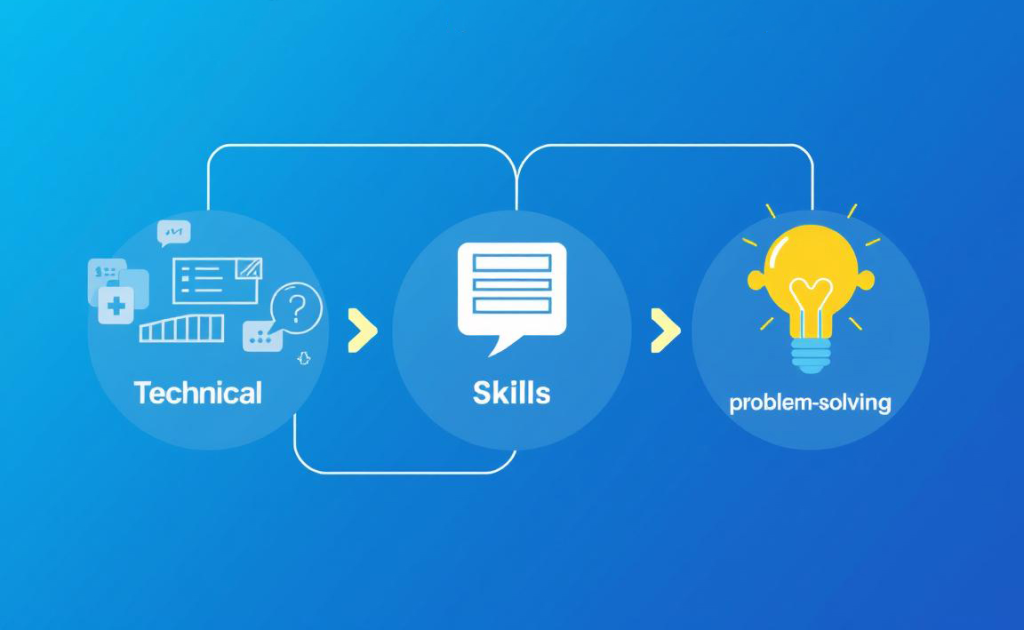
Prompt Engineering Techniques
Beyond general skills, prompts engineers need to master specific techniques that improve AI outputs:
| Technique | Description | Application |
| Zero-shot prompting | Providing direct instructions without examples | Simple, straightforward tasks |
| Few-shot prompting | Including examples of desired input-output pairs | Complex tasks requiring pattern recognition |
| Chain-of-thought prompting | Breaking down reasoning into step-by-step process | Problem-solving and logical reasoning tasks |
| Role prompting | Assigning a specific role or persona to the AI | Specialized knowledge domains or writing styles |
| Iterative refinement | Gradually improving prompts based on outputs | Fine-tuning responses for specific use cases |
📊 Prompt Engineering in Practice: Good vs Bad Examples
| Task | ❌ Bad Prompt | ✅ Good Prompt | Why It’s Better | Result Quality |
|---|---|---|---|---|
| Content Writing | “Write about dogs” | “Write a 300-word informative article about Golden Retrievers for first-time dog owners. Include: temperament, care requirements, and exercise needs. Tone: friendly and encouraging.” | Specific length, audience, structure, and tone | 8/10 vs 3/10 |
| Code Generation | “Make a login system” | “Create a secure user authentication system in Python using Flask and bcrypt. Include: email/password validation, password hashing, session management, and error handling. Add inline comments explaining security measures.” | Technology stack, security focus, documentation | 9/10 vs 4/10 |
| Data Analysis | “Analyze this data” | “You are a data analyst. Analyze this sales data from Q4 2024. Identify: top 3 performing products, revenue trends, seasonal patterns, and underperforming categories. Present findings in bullet points with specific numbers.” | Role assignment, specific analysis goals, format | 9/10 vs 4/10 |
| Creative Writing | “Write a story” | “Write a 500-word mystery short story in the style of Agatha Christie. Setting: 1920s English manor. Include: unexpected twist, 3 suspects, and clues hidden in dialogue. Tone: suspenseful but family-friendly.” | Genre, style reference, constraints, requirements | 8/10 vs 3/10 |
| Translation | “Translate this to Spanish” | “Translate this product description to Latin American Spanish. Maintain: professional tone, brand voice (friendly, approachable), and cultural appropriateness for Mexican market. Highlight benefits, not just features.” | Regional dialect, tone, cultural context, focus | 9/10 vs 5/10 |
Industries Adopting Prompt Engineering
Prompt engineering is rapidly becoming essential across diverse sectors as organizations seek to leverage AI capabilities effectively. The specialized knowledge of prompts engineers is transforming how businesses interact with and benefit from AI technologies.

Healthcare
Medical institutions use prompt engineering to improve diagnostic assistance, patient communication, and medical research. Carefully crafted prompts help ensure AI systems provide accurate, contextually appropriate information while maintaining patient privacy and ethical standards.
Finance
Financial services leverage prompt engineering for risk assessment, fraud detection, and personalized financial advice. Prompts engineers work to create systems that can analyze complex financial data while adhering to regulatory requirements and maintaining security.
Content Creation
Media companies and marketing agencies employ prompt engineering to generate articles, social media content, and creative materials. The focus is on developing prompts that maintain brand voice, ensure factual accuracy, and spark creativity.
Legal
Law firms use prompt engineering to assist with legal research, document review, and contract analysis. Precision in prompt design is crucial to ensure accurate interpretation of legal concepts and compliance with jurisdictional requirements.
Education
Educational institutions implement prompt engineering to create personalized learning experiences, develop educational content, and provide tutoring assistance. Prompts are designed to be pedagogically sound and adaptable to different learning styles.
Software Development
Tech companies employ prompt engineering to enhance code generation, debugging assistance, and technical documentation. Engineers focus on creating prompts that understand programming concepts and produce secure, efficient code.
Industry-Specific Prompt Engineering
Discover how to apply prompt engineering techniques to your specific industry with our specialized workshops. Learn from experts who understand your sector’s unique challenges.Explore Industry Workshops
Career Outlook and Salary Ranges
As AI adoption accelerates across industries, the demand for skilled prompts engineers continues to grow. This emerging specialization offers promising career prospects with competitive compensation.
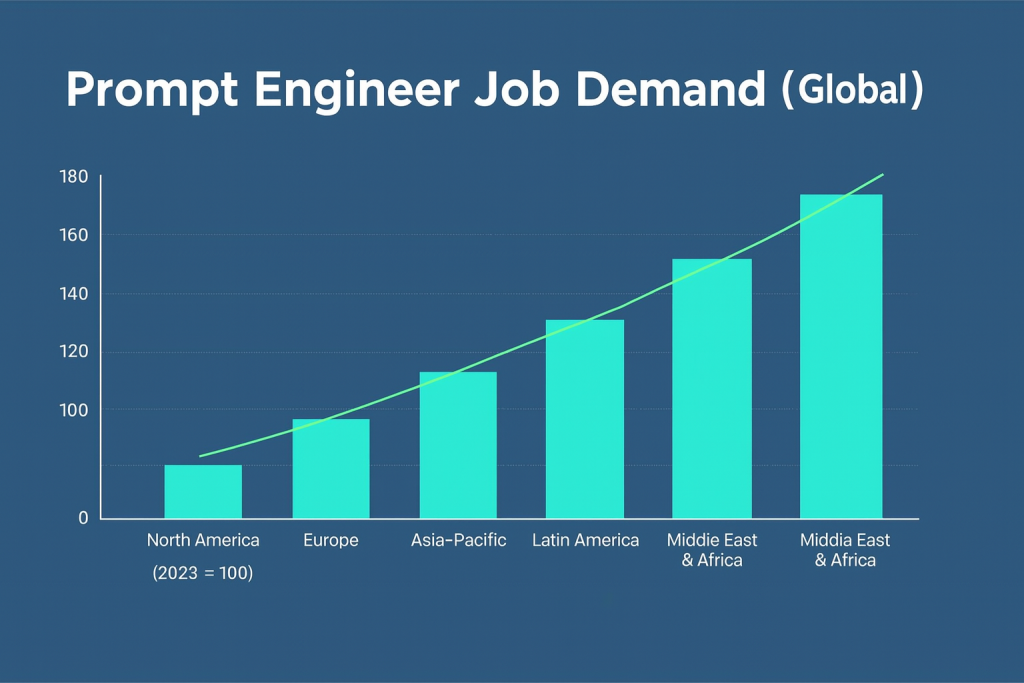
Market Demand
According to recent industry reports, prompt engineering roles have seen a 300% increase in job postings over the past year. This growth is expected to continue as more organizations recognize the value of optimizing their AI interactions.
| Region | Entry-Level Salary | Mid-Level Salary | Senior-Level Salary |
| North America | $85,000 – $110,000 | $110,000 – $150,000 | $150,000 – $200,000+ |
| Europe | €60,000 – €80,000 | €80,000 – €120,000 | €120,000 – €160,000+ |
| Asia-Pacific | $50,000 – $75,000 | $75,000 – $110,000 | $110,000 – $150,000+ |
| Remote/Global | $70,000 – $90,000 | $90,000 – $130,000 | $130,000 – $180,000+ |
Career Progression
The career path for prompts engineers typically follows this progression:
- Junior Prompt Engineer: Focus on implementing established prompt patterns and learning fundamental techniques
- Prompt Engineer: Develop custom prompt strategies and optimize existing systems
- Senior Prompt Engineer: Lead prompt design for complex applications and mentor junior team members
- Prompt Engineering Lead/Manager: Oversee prompt engineering teams and develop organizational strategies
- AI Interaction Architect: Design comprehensive AI interaction systems that may include multiple models and interfaces
Industry Insight: Many organizations are creating hybrid roles that combine prompt engineering with related skills such as UX design, data science, or content strategy. These positions often command premium salaries due to their versatility.
🛠️ Essential Tools & Resources for Prompt Engineers
| Category | Tool/Resource | Purpose | Cost | Link |
|---|---|---|---|---|
| AI Platforms | ChatGPT (OpenAI) | Practice prompt engineering | Free + Paid | chat.openai.com |
| Claude (Anthropic) | Advanced reasoning, long context | Free + Paid | claude.ai | |
| Gemini (Google) | Multimodal prompting | Free | gemini.google.com | |
| Microsoft Copilot | Integrated AI assistant | Free + Paid | copilot.microsoft.com | |
| Learning | Prompt Engineering Guide | Comprehensive documentation | Free | promptingguide.ai |
| OpenAI Cookbook | Official examples & tutorials | Free | github.com/openai | |
| Learn Prompting | Interactive course | Free | learnprompting.org | |
| Communities | r/PromptEngineering | Reddit community | Free | reddit.com |
| Prompt Engineering Discord | Real-time discussions | Free | Various servers | |
| AI Stack Exchange | Q&A community | Free | ai.stackexchange.com | |
| Testing | PromptPerfect | Optimize prompts automatically | Free trial | promptperfect.jina.ai |
| PromptBase | Marketplace for prompts | Varies | promptbase.com | |
| Documentation | LangChain Docs | Framework for LLM apps | Free | docs.langchain.com |
| Hugging Face | Model documentation | Free | huggingface.co | |
| Courses | DeepLearning.AI | ChatGPT Prompt Engineering | Free | deeplearning.ai |
| Coursera | Prompt Engineering Specialization | Paid | coursera.org |
💡 Pro Tip: Start with free platforms (ChatGPT, Claude, Gemini) for daily practice. Join at least one community to stay updated on techniques and job opportunities. Complete one free course (DeepLearning.AI recommended) within your first month.
Step-by-Step Guide to Becoming a Prompts Engineer
Breaking into the field of prompt engineering requires a strategic approach to skill development and professional positioning. Follow this roadmap to build your career as a prompts engineer.
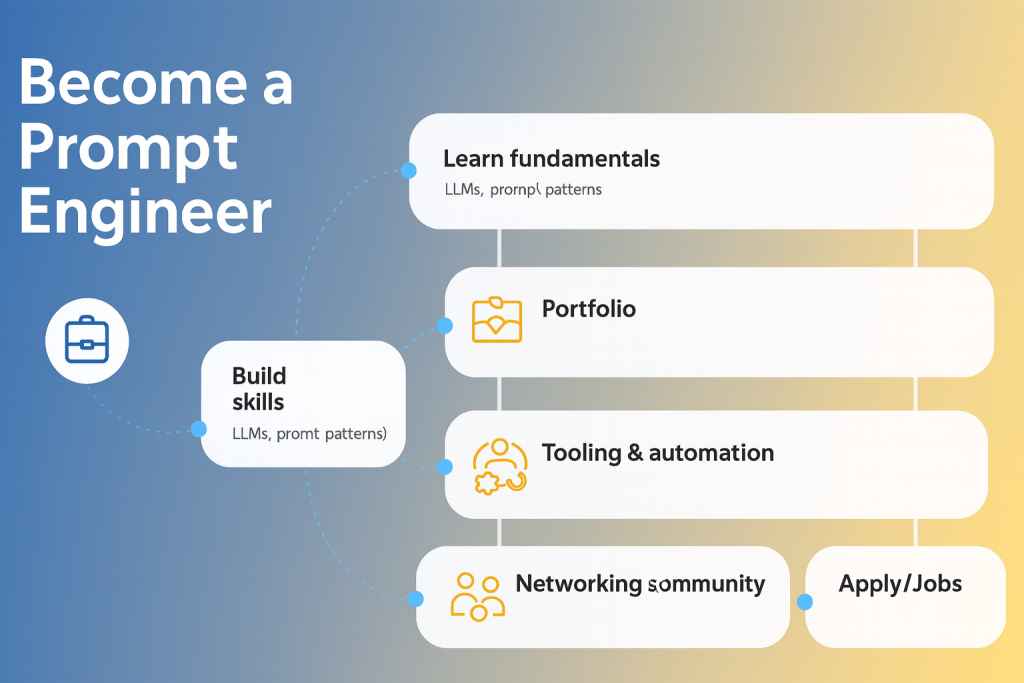
1. Build Your Foundation
Educational Background
While no standardized degree exists specifically for prompt engineering, the following educational paths provide valuable foundations:
- Computer Science or Software Engineering
- Computational Linguistics or NLP
- Data Science or Machine Learning
- Human-Computer Interaction
- Cognitive Science
Self-Directed Learning
Supplement formal education with specialized knowledge:
- Online courses in prompt engineering and LLMs
- AI model documentation (e.g., GPT, BERT, T5)
- Natural language processing tutorials
- Programming fundamentals (especially Python)
- AI ethics and responsible design principles
2. Develop Practical Skills
Theory alone isn’t enough—hands-on experience is crucial:
- Experiment with publicly available AI models like ChatGPT, Claude, or Bard
- Document your prompt experiments and their results
- Join prompt engineering communities to learn from others
- Participate in prompt engineering challenges and competitions
- Contribute to open-source AI projects that involve prompt design
3. Build a Portfolio
Create tangible evidence of your prompt engineering abilities:
- Document case studies of prompt optimization with before/after results
- Create a prompt template library for common use cases
- Develop a personal blog discussing prompt engineering techniques
- Contribute to prompt engineering discussions on platforms like GitHub
- Create demonstrations of innovative prompt applications
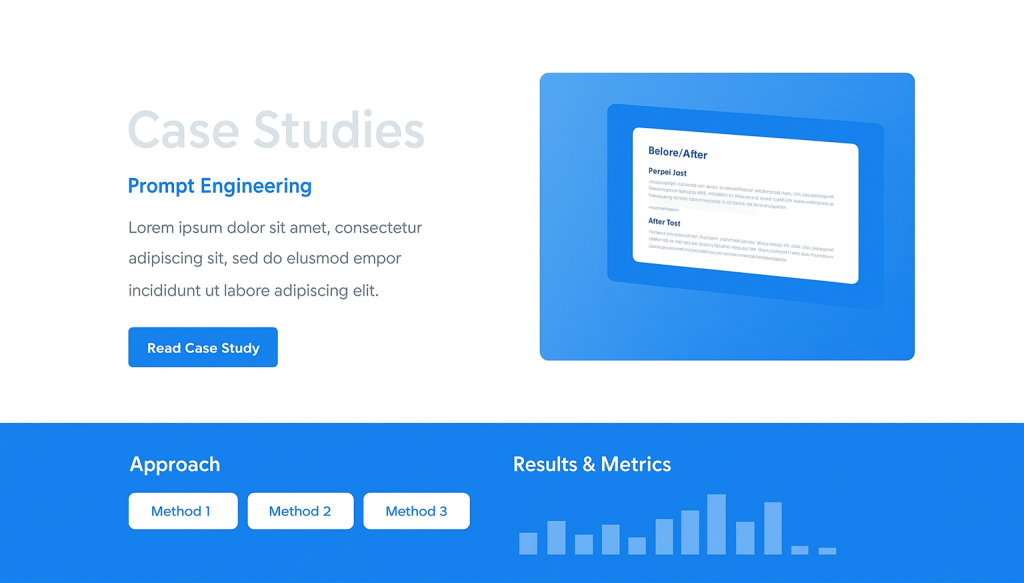
4. Network and Position Yourself
Connect with the growing community of AI professionals:
- Join AI and NLP-focused communities on Discord, Reddit, and Slack
- Attend AI conferences and workshops
- Connect with prompt engineers on LinkedIn
- Participate in hackathons focused on AI applications
- Share your insights through social media and technical forums
5. Apply for Opportunities
Target positions that match your skills and interests:
- Dedicated prompt engineer roles at AI companies
- AI content specialist positions
- NLP engineer roles with prompt engineering components
- AI product development teams
- Consulting opportunities for organizations implementing AI
Fast-Track Your Prompt Engineering Career
Get personalized guidance from industry experts with our mentorship program. Receive feedback on your portfolio, interview preparation, and career strategy.Join Our Mentorship Program
Case Studies: Successful Prompt Engineering Implementations
Examining real-world applications of prompt engineering provides valuable insights into effective strategies and their impact. These case studies demonstrate how thoughtful prompt design transforms AI interactions.
Case Study 1: Healthcare Diagnostic Assistant

Challenge:
A healthcare technology company needed to improve their AI diagnostic assistant’s accuracy in interpreting patient symptoms and suggesting potential conditions for physician review.
Prompt Engineering Approach:
- Implemented structured input format for symptom description
- Added medical context priming before each query
- Developed chain-of-thought prompting to mimic clinical reasoning
- Created specialized prompts for different medical specialties
Results:
The redesigned prompt system improved diagnostic suggestion accuracy by 37% and reduced irrelevant suggestions by 62%. Physicians reported higher confidence in the AI assistant’s recommendations and increased usage rates.
Case Study 2: Legal Document Analysis

Challenge:
A legal tech startup needed to improve their contract analysis tool’s ability to identify potential risks and unusual clauses in legal documents.
Prompt Engineering Approach:
- Developed multi-stage prompting pipeline for progressive analysis
- Created specialized legal context primers for different contract types
- Implemented comparative prompting against standard clause libraries
- Added confidence scoring prompts for uncertain interpretations
Results:
The enhanced prompt system increased risk identification accuracy by 43% and reduced false positives by 28%. Contract review time decreased by an average of 3 hours per document, and client satisfaction scores improved significantly.
Case Study 3: E-commerce Product Description Generation

Challenge:
An e-commerce platform needed to scale their product description creation while maintaining brand voice and improving conversion rates.
Prompt Engineering Approach:
- Created brand voice primers with distinctive examples
- Developed structured input templates for product attributes
- Implemented audience-specific prompting for different customer segments
- Added benefit-focused instruction layers to highlight product value
Results:
The new prompt system reduced description creation time by 78% while maintaining quality standards. A/B testing showed a 23% increase in conversion rates for AI-generated descriptions compared to previous templates. The system now handles 95% of new product listings with minimal human editing.
“The difference between a good AI implementation and a great one often comes down to the quality of prompt engineering. It’s the hidden force multiplier that determines whether AI truly delivers on its promise.”
– Michael Rodriguez, Chief AI Officer at Enterprise Solutions
Future Trends in Human-AI Interaction Design
The field of prompt engineering continues to evolve rapidly. Understanding emerging trends helps prompts engineers stay ahead of the curve and prepare for the next generation of AI interactions.

Multimodal Prompting
Future prompt engineering will extend beyond text to incorporate multiple input and output modalities:
- Combined text, image, and audio prompts for richer context
- Gesture and spatial prompting for AR/VR environments
- Emotional and sentiment-aware prompting systems
- Real-time environmental context integration
Adaptive and Personalized Prompting
AI systems will increasingly customize their interaction based on user patterns:
- Dynamic prompt adjustment based on user expertise level
- Personalized prompt templates reflecting individual communication styles
- Learning systems that improve prompts based on user feedback
- Context-aware prompting that considers user history and preferences
Collaborative Human-AI Prompt Design
The boundary between human and AI contributions to prompt engineering will blur:
- AI-assisted prompt optimization tools
- Hybrid systems where humans and AI collaboratively refine prompts
- Prompt marketplaces for sharing effective templates
- Community-driven prompt libraries and standards
Ethical and Responsible Prompting
As AI capabilities grow, ethical considerations in prompt design become increasingly important:
- Transparency indicators for AI-generated content
- Bias detection and mitigation in prompt systems
- Ethical guidelines and certification for prompt engineers
- Regulatory frameworks addressing prompt manipulation
Expert Prediction: Within the next five years, we’ll likely see the emergence of specialized prompt engineering tools that automatically test and optimize prompts across different models and use cases, similar to how A/B testing works for websites today.
Conclusion: The Growing Importance of Prompts Engineer
As AI systems become increasingly integrated into our daily lives and business operations, the role of prompts engineers will only grow in importance. These specialists serve as the crucial bridge between human intent and machine capability, ensuring that AI tools deliver maximum value while maintaining ethical standards.
The field offers exciting opportunities for those with the right blend of technical knowledge, creative thinking, and communication skills. Whether you’re a seasoned AI professional looking to specialize or someone new to the field, developing prompt engineering expertise positions you at the forefront of the AI revolution.
By mastering the art and science of effective prompts, you can help shape how humans and AI systems collaborate to solve problems, create value, and build a better future.
Begin Your Prompt Engineer Journey Today
Ready to develop the skills that will define the future of AI interaction? Our comprehensive prompt engineering course provides everything you need to excel in this exciting field. Enroll in Our Complete Prompt Engineering Course
Frequently Asked Questions
Do I need a computer science degree to become a prompts engineer?
No, a CS degree is not strictly required. While it helps, many successful prompt engineers come from diverse backgrounds including linguistics, writing, psychology, and design. What matters most is understanding how AI works, strong communication skills, and the ability to think systematically. You can learn the technical fundamentals through online courses and hands-on practice.
How long does it take to become proficient in prompts engineering?
With dedicated practice, you can develop basic prompt engineering skills in 2-3 months. However, becoming truly proficient typically takes 6-12 months of consistent experimentation, learning, and real-world application. The field is still evolving, so continuous learning is essential even for experienced practitioners.
Can prompt engineering be automated?
Partially, yes. AI tools can help optimize and test prompts, but human creativity and strategic thinking remain crucial. The best results come from combining automated optimization with human insight about context, nuance, and user needs. Think of automation as an assistant, not a replacement.
What’s the difference between prompt engineer and AI training?
AI training involves creating and fine-tuning the underlying machine learning models themselves—a highly technical process requiring data science expertise. Prompt engineering works with existing trained models to optimize how we communicate with them. It’s like the difference between building a car (AI training) and learning to drive it expertly (prompt engineering).
Is prompt engineering a stable career path?
While AI technology evolves rapidly, the core skill of effective human-AI communication will remain valuable. As AI systems become more sophisticated, the need for experts who can optimize these interactions will likely grow. The role may evolve, but the fundamental demand for bridging human intent and machine capabilities appears stable for the foreseeable future.
Which AI models should I practice with as a beginner?
Start with freely accessible models like ChatGPT, Claude, Google Gemini, or Bing Chat. These platforms allow unlimited experimentation without technical setup. As you advance, explore API access to models like GPT-4, Claude, or open-source alternatives like Llama to understand different model behaviors and capabilities.
📖 Continue Learning About AI
- → Artificial Intelligence SEO: 5 Strategies You Need to Follow Master AI-powered SEO techniques for better rankings
- → DeepSeek vs ChatGPT: Tutorial for Beginners Compare popular AI tools and find the right one for you
- → AI Application: Transforming Industries with Intelligent Automation See how AI is changing different industries
- → Privacy and AI: Protecting Your Data in an AI-Powered World Learn about AI privacy and data protection
- → How AI Assists Small Business Email Management and Communication Practical AI applications for business communications
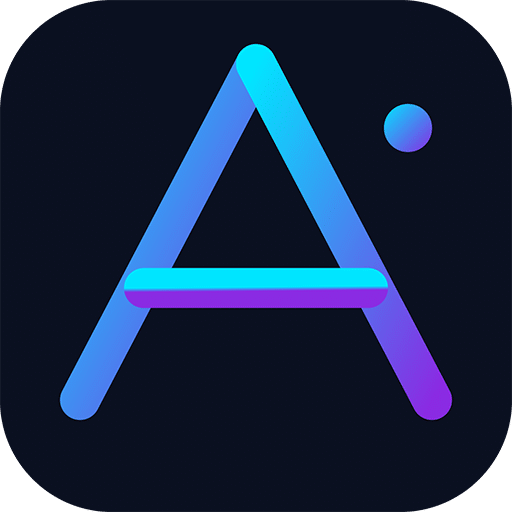
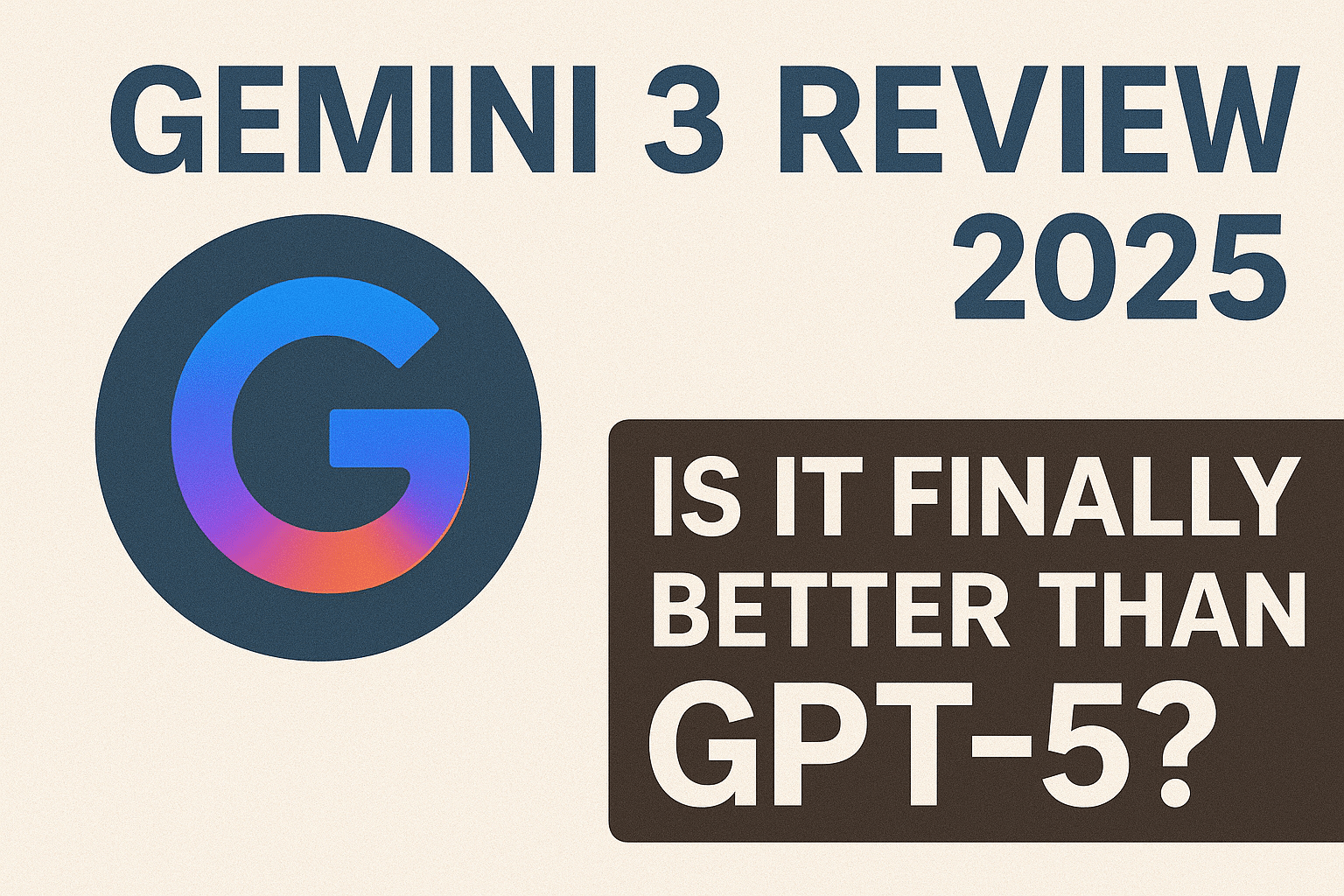
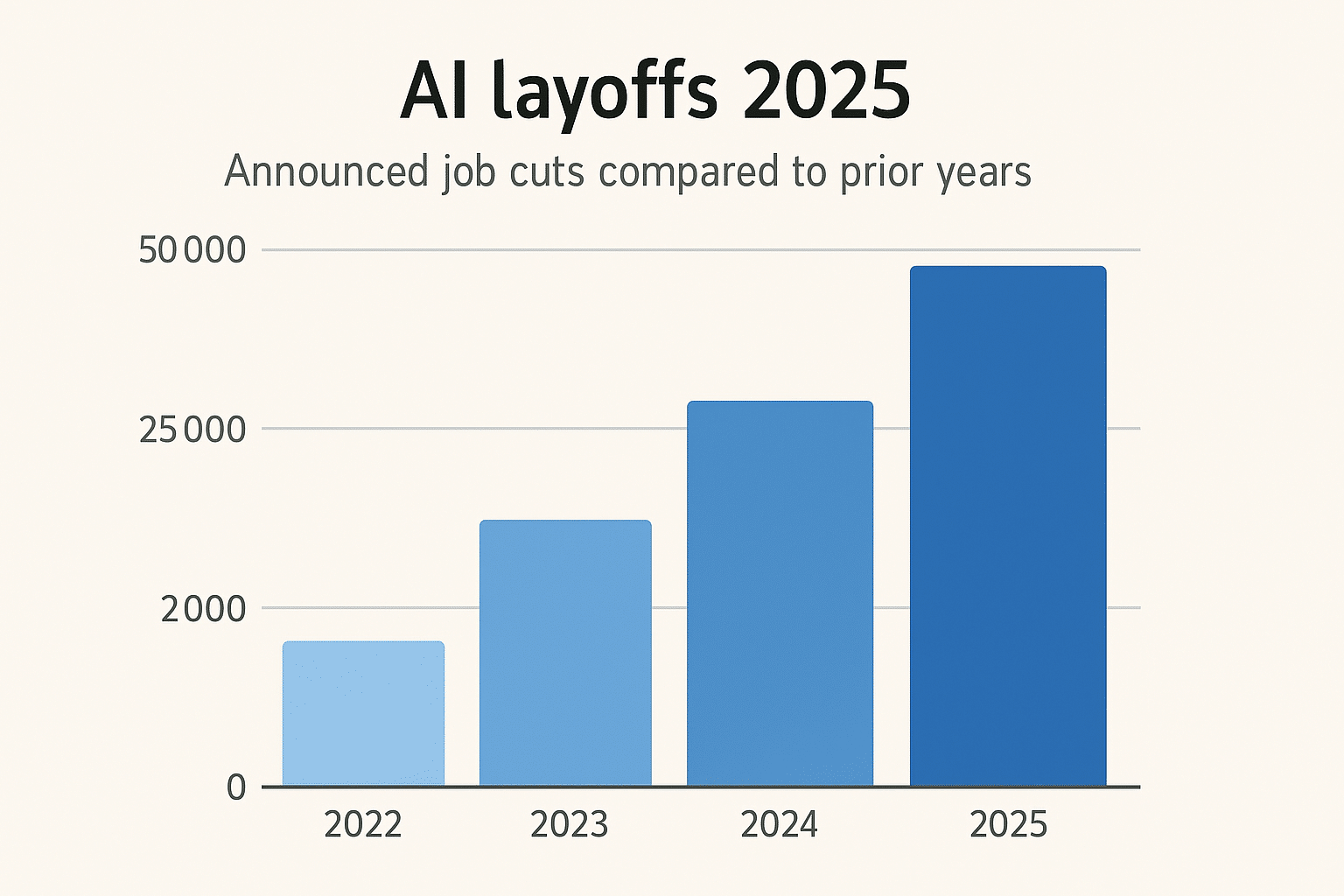






Leave a Reply